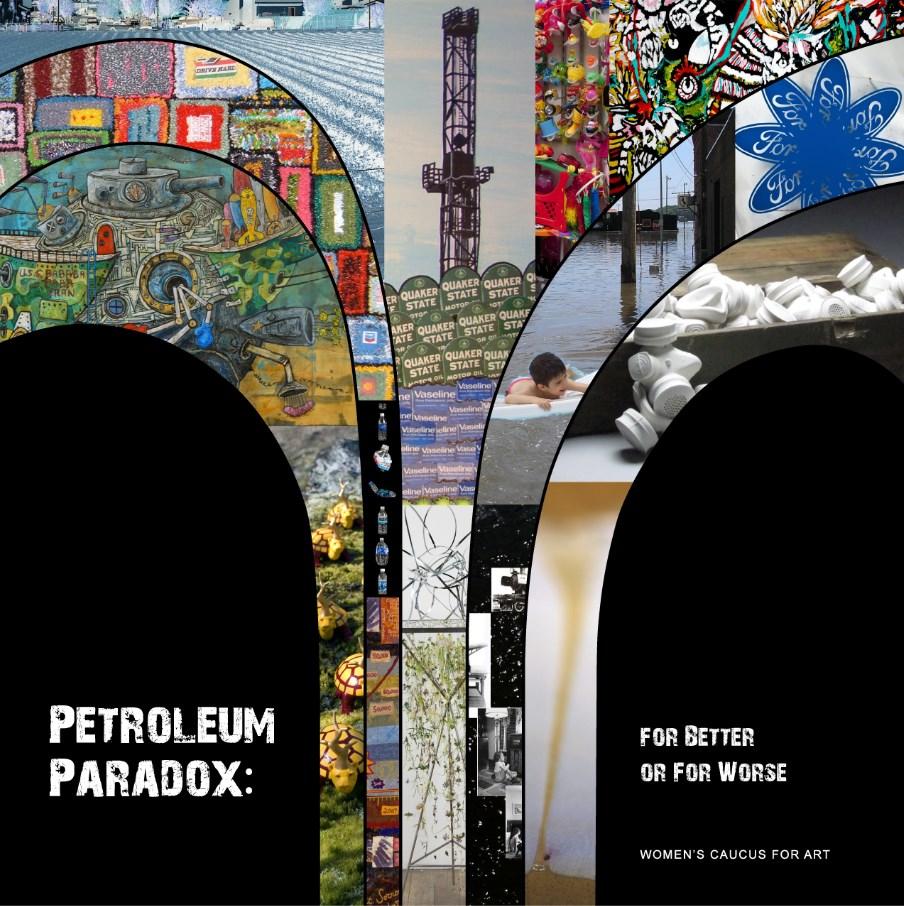
Copyright 2012 by the Women’s Caucus for Art. The book author and each artist here, retains sole copyright to their contributions to this book.
Catalog designed and edited by Karen Gutfreund, National Exhibition Director and Karin Luner, Director of Operations, Women’s Caucus for Art
Cover Design by: Rozanne Hermelyn, Arc and Line Communication and Design. www.arcandline.com
ISBN: 978-0-9831702-4-2
2
Petroleum Paradox: For Better or For Worse?
National Juried Exhibition
Presented by the Women’s Caucus for Art Juror
Eleanor Heartney
Contributing Editor
Art in America and art press at Denise Bibro Fine Art 529 West 20th Street New York, New York
May 24 to June 23, 2012
3
FROM THE PRESIDENT
Congratulations to all of the artists represented in Petroleum Paradox. True to our mission of creating community through art, education and social activism, this exhibition raises questions about our dependence on fossil fuel.
Several years ago, I visited Oil Creek State Park, just outside of Titusville, PA. This was the site of the 1850’s oil rush, which transformed this small, rural community into a bustling oil production center with wells, transport trains and refineries. I purchased sepia-toned postcards at the museum that captured the oil gushing up through wooden derricks. They reminded me of an oil town near Veracruz, Mexico that I drove through in 1989. I could taste the pollution in the thick, brown air, and our VW Golf was nearly crushed by transport trucks streaming in and out from all directions. In the front yards of every house, pools of dark oil seeped up from the ground. It was the 20th Century version of Titusville. The paradox lies in the fact that despite the problems wrought by fossil fuel, most of us cannot live without car, bus, airplane, boat, electricity, or heating.
Petroleum Paradox is intended to stir dialog between art and observer, artist and audience, artist and critic, and among the viewers of the exhibition. I invite you to formulate your own point of view about fuel dependency and alternatives to fossil fuel.
Priscilla Otani, WCA President

4
From the Exhibition Director
Art can be a powerful, productive force and instrumental in sparking change or critical thinking. The Women’s Caucus for Art is committed to supporting local, national, and global art activism. Art can produce a visceral response and can provoke, inspire, or disturb, and opens your eyes to worlds other than your own. While the artist may not consider themselves to be a revolutionary, by bringing to light issues and concerns, art can effect change. We need of works that help us to understand what is happening in our society, who we are, where we come from and where we’re going.
With our prospectus for Petroleum Paradox: For Better or For Worse, we asked for works that stir emotions, discussion and debate about our petroleum-dependent world. Examples include, but were not limited to, works that address the impact of collecting, processing and delivering fossil fuel on the environment; global warming; the power of big oil companies to control countries and governments; an imagined life without fossil fuel; and life forms that were the origins of fossil fuel. According to Annenberg, “The discovery of oil, in 1859, in Pennsylvania, transformed our way of life; we are enveloped by petroleum products—from the shoes we wear, to the materials our clothes are made of, to the way we heat our houses, to our modes of transportation. Oil dependency pollutes the environment causing respiratory illness, endangers wildlife, and necessitates the large scale loss of life as we search to secure sources of oil overseas. How do we initiate change with this rush to grab dwindling non-renewable energy assets, instead of focusing on renewable energy and the prevention of global warming?” This exhibition manifests the artists response to the Petroleum Paradox and what is happening in our oil dependent society and world.
Eleanor Heartney, Contributing Editor, Art in America and Artpress, chose 72 artists for Petroleum Paradox with 31 works in the gallery at Denise Bibro Fine Art and an additional 43 featured in the catalog. This show is in collaboration with Denise Bibro of Denise Bibro Fine Art. We are honored to work with these artists and to showcase their work. We believe in the power of artists to create, connect, and change the world.
Thank you to Denise Bibro for partnering with us to put on this exhibition and Eleanor Heartney for compiling an incredible body of work on this activist from almost 500 submissions. A big thank you to Marcia Annenberg, the co-director for this exhibition and co-president of the New York WCA chapter, to Rozanne Hermelyn for the catalog cover design, and to Karin Luner for her excellent editing skills and operational support. And most of all, a heartfelt thanks to the Board and members of Women’s Caucus for Art for their ongoing work to create greater exposure for women in the arts and art as activism.
Karen Gutfreund Vice President National Exhibitions Director Women’s Caucus for Art
5
Petroleum Paradox
America is at a crossroads. As new techniques of petroleum extraction increase available oil and gas, once again, our country will be in a position to lead in fossil fuel production. Oil and gas companies are active in the tar sands of Canada. Fracking has released natural gas in North Dakota, Texas and Pennsylvania. Deepwater drilling resumed in the Gulf of Mexico. What is the environmental cost of these methods? In Canada, the loss of Boreal forest and peatlands, due to the clearing of woodlands for the oil industry, destroys the earth’s ability to absorb Co2. Carbon Dioxide is one of the major gases responsible for global warming. Fracking has been shown to contaminate groundwater. Tons of chemicals push through sediment and infiltrate the aquifers upon which we depend for our drinking water. The BP disaster destroyed much marine life in the Gulf.
Al Gore’s film, An Inconvenient Truth, tied the rise in global temperatures to the increase in CO2 in the atmosphere, according to scientific measurements. The rise in CO2 has been linked directly to the burning of fossil fuels by industry. The film stated further, that, there is a ten year window before global climate change becomes irreversible. What is the tipping point and why aren’t we informed what that point is? Why does the price of a gallon of gas become the focus of our energy policy instead of the destruction of the earth’s ecosystems? How has the media dodged its responsibility for the lack of a national dialog on the consequences of inaction? Ongoing denial of climate change and its causes, by some political leaders, creates a campaign of misinformation and confusion that impedes constructive action.
Are there any signs that we are moving urgently to address this problem? There are hopeful indications that we are. For example, a recent law, passed in Congress, increased gas mileage in cars. The production of electric vehicles has revived. Solar and wind energy projects are starting to replace coal, oil and nuclear energy. If the American people don’t demand clean, renewable forms of energy, the self-interest of oil and gas companies will prevail, to keep our society tied to forms of energy that will add to global warming, which will ultimately change life on earth as we know it.
This exhibit seeks to raise awareness of the imminent danger of uncontrolled climate change, caused by an excessive dependency on fossil fuels. It is my hope that the American people will demand change to a reliance on clean energy. It is our generation that has been called to this task. It will be our generation that makes a difference in these perilous times.
Marcia Annenberg Co-President Co-Director for Petroleum Paradox New York Women’s Caucus for Art
6
About The Women’s Caucus for Art:
The Women’s Caucus for Art was founded in 1972 in connection with the College Art Association (CAA). WCA is a national member organization unique in its multidisciplinary, multicultural membership of artists, art historians, students, educators, and museum professionals.

The mission of the Women’s Caucus for Art is to create community through art, education, and social activism. WCA is committed to recognizing the contribution of women in the arts; providing women with leadership opportunities and professional development; expanding networking and exhibition opportunities for women; supporting local, national and global art activism; and advocating for equity in the arts for all.
As an NGO (non-governmental organization) of the United Nations, the Women’s Caucus for Art actively supports the UN Millennium Goals. WCA utilizes art as the universal language to engage artists, NGOS, and civil society on a broad range of issues such as gender equity and environmental sustainability.
As a founding member of the Feminist Art Project, WCA is part of a collaborative national initiative celebrating the Feminist Art Movement and the aesthetic, intellectual and political impact of women on the visual arts, art history, and art practice, past and present.
OUR MISSION
The mission of the Women’s Caucus for Art is to create community through art, education, and social activism.
We are committed to:
recognizing the contributions of women in the arts
providing women with leadership opportunities and professional development
expanding networking and exhibition opportunities for women
supporting local, national, and global art activism
advocating for equity in the arts for all
For more information visit: www.nationalwca.org
P. O. Box 1498, Canal Street Station, New York, NY 10013-1498 info@nationalwca.org, Tel: 212.634.0007
www.facebook.com/groups/107511953206/ twitter.com/#!/artWCA
7
Denise Bibro Fine Art began exhibiting a diverse group of contemporary artists in corporate and alternative spaces in 1980. After showcasing work at her art salon in Union Square, 1992 saw the opening of her first gallery in SoHo. Denise Bibro Fine Art moved to its current Chelsea location in 1997. The new space encompasses the main gallery as well as a project space, Platform, providing over 4,000 square feet of exhibition space. Presenting and promoting both emerging and established artists, the gallery has an emphasis on painting, works on paper, sculpture, and multi-media works. The programming for Platform explores more conceptual work, including video and installation works, as well as presenting collaborative projects with other curators and dealers.
Denise Bibro Fine Art supports all work of quality and content regardless of gender and ethnicity, while also having a long history of support for women artists and women issues. The gallery has always been sensitive to women in the arts and has supported the Women’s Caucus for Art in the past. In 1994, in collaboration with New York WCA, Ms. Bibro hosted the exhibition A Body of Work Women’s Health Show at her SoHo gallery. In Chelsea, Denise Bibro Fine Art hosted an exhibition for the National Association of Women Artists, NYC Chapter, titled Men and is excited to host the WCA exhibit Petroleum Paradox: For Better or For Worse in May through June 2012.
Denise Bibro was a panelist for the Symposium on Women Artists and Political Art at the Barnard College Conference on Women in Art in 1986. That same year, Ms. Bibro took part in the exhibit The Homeless in NYC, a pictorial essay by Marilyn Herbert sponsored by Citizens for Children.
Denise Bibro Fine Art 529 West 20th Street, New York, NY 212 647 7030

8
www.denisebibrofineart.com
One of Denise Bibro Fine Art’s exclusive artists, Carol Jacobsen, a long-time feminist and women’s advocate with an emphasis on human rights and justice for incarcerated women recently had an exhibition Mistrial at the gallery which also traveled to John Jay College of Criminal Justice in New York, NY. Jacobsen will take part in the International Human Rights Conference in June, 2012 at John Jay College.
Denise Bibro Fine Art represents the following women artists:
Dusty Boynton
Sara Crisp
Lisa Dinhofer
Iona Fromboluti
Carter Hodgkin
Carol Jacobsen
Linda Lippa
Roslyn Meyer
Nora Speyer
Audrey Ushenko
Jan Wunderman
Denise Bibro Fine Art 529 West 20th Street, New York, NY 212 647 7030 www.denisebibrofineart.com
9
Petroleum Paradox: For Better or For Worse?
by: Eleanor Heartney
After decades of a laissez faire attitude toward our energy needs, a perfect storm of current events among them wars and armed conflicts in the Middle East, growing evidence of climate change, and the emergence of huge new markets for energy in developing countries like China and India—have placed the question of fossil fuels firmly at the center of our political, economic and social debates. How do we balance economic development, environmental protection, and geopolitical stability in an ever more precarious world? What are we willing to give up today to avoid catastrophe tomorrow? Where should we commit our resources? How should we define our social and economic priorities?
Such questions underlie the thoughtful works that comprise this exhibition. Artists, no less than the rest of us, are challenged to identify problems and seek solutions to the treacherous situation created by our insatiable appetite for energy. The works here come at this dilemma from a variety of perspectives and employ rhetorical devices that encompass humor, elegy, agit-prop and poetry. Using formats that include photography, video, painting, sculpture, performance and installation, the artists represented here counsel concern but not despair. In the process they reinforce the paradox at the center of our environmental predicament. Human creativity and innovation are at the root of our difficulties. But they are also the source of our potential salvation.
About the Juror
Eleanor Heartney, is a Contributing Editor to Art in America and art press and has written extensively on contemporary art issues for such other publications as ARTnews, Art and Auction, The New Art Examiner, The Washington Post, and The New York Times. She received the College Art Association’s Frank Jewett Mather Award for distinction in art criticism in 1992. Her books include: Critical Condition: American Culture at the Crossroads (Cambridge University Press, 1997); Postmodernism (Cambridge University Press, 2001); Postmodern Heretics: The Catholic Imagination in Contemporary Art (Midmarch Arts Press, 2004); Defending Complexity: Art, Politics and the New World Order (Hard Press Editions, 2006) and Art and Today (Phaidon Press Inc., 2008), a survey of contemporary art of the last 25 years from Phaidon. She is a co-author of After the Revolution: Women who Transformed Contemporary Art (Prestel Publishing, 2007), which won the Susan Koppelman Award. Heartney is a past President of AICA-USA, the American section of the International Art Critics Association. In 2008 she was honored by the French government as a Chevalier dans l’Ordre des Arts et des Lettres.
10
11
Petroleum Paradox ARTISTS
* denotes artists exhibited at Denise Bibro Fine Art
12
Outcome: Simply put, this is the eventual outcome of global warming, with a hot yellow and orange fog overwhelming blackened, thin, weak trees.

Welcome: Welcome to the future, if our leaders continue to have a single-minded attitude towards finding fossil fuels, and an obstinate denial about what is happening to Earth and its atmosphere.
Tears: Tears will be the only things left to moisten a ravaged landscape as more and more areas (e.g., the Arctic) are explored for fossil fuels.
13
Elaine Alibrandi. Outcome. 2001. Painted aluminum foil on canvas. 37 x 37 x 3 inches. *
My pieces are a criticism of nationalism, power brokers, and corporate greed exerted for the control over the world’s oil supply. The avarice for this singular commodity pollutes all of our intentions, our honesty and the common welfare of the planet. Wasteland refers to the wasteful reality of the United States two incursions into Iraq. U.S.S. Rummy, is about the misguided nature of our efforts for control wrapped up in our war machine. CondiBomb, correlates to our failure to accomplish a lasting peace in the region.

14
Scott Anderson. CondiBomb, Weapon of Missed Diplomacy and Messed Democracy. 2010. Acrylic and ink. 57 x 96 inches.
Our society is inundated with petroleum products. What is the human and environmental cost of this oil dependency? From electronics to clothes to cars, our way of life has become dependent on petroleum. Why isn’t clean renewable energy a priority? Fracking will contaminate our groundwater and the extraction of tar sands will add to global warming. Offshore drilling has been shown to devastate ocean ecosystems when accidents occur. When will the American people demand a better future for our children and grandchildren?

15
Marcia Annenberg. Here’s Looking at You, Kid. 2011. Mixed media. 72 x 22 x 10 inches.
In our lust for more fossil fuels, fracking, a process of extracting natural gas from the ground, is poisoning our water supplies, our bodies the entire environment. At what cost do we continue to allow the gas and oil industries to rape the planet? A paranoiac’s response to raise awareness.


16
Krisanne Baker. Content Aware Anxieties. 2012. Digital video with 2 channel audio. 720 x 480 DVCPRO NTSC R0 / 05:51. *
Instead of finding renewable energy sources, we continue to search for more oil. Oil is the evil for recent wars and seems to be more important than the destruction of the environment and loss of human lives. War toys and toy cars only encourage our children to continue the madness.

17
Ulla Barr. Round and Around We Go. 2012. Digital print mounted on Gator Board. 20 x 30 inches.
These works feature scanned images of the earliest images made of the carboniferous forest (the prehistoric plants that became coal) combined with photographs of crude oil. Some images feature petroleum from Titusville, PA, the site of Drake Well, the first commercial oil well in the U.S. The other prints use petroleum from Saudi Arabia. To create the images, I use oil and water techniques that were done in live light shows at rock concerts in the 1960’s and photograph the projections.

18
Kristen Baumlier. Crude Oil/Carboniferous Forest 2. 2007. Duratrans Print. 38 x 38 inches.
My paintings ponder the U.S. involvement in Iraq and Afghanistan: Are we really protecting the U.S. against terrorists? Is the separation of church and state an American myth? Can we believe our involvement is really not about the oil? Facts difficult to dismiss: The Pentagon uses 22 gallons of oil per soldier per day deployed in its wars, a figure that’s expected to grow 1.5% annually through 2017, making the Pentagon the largest consumer of petroleum in the U.S.
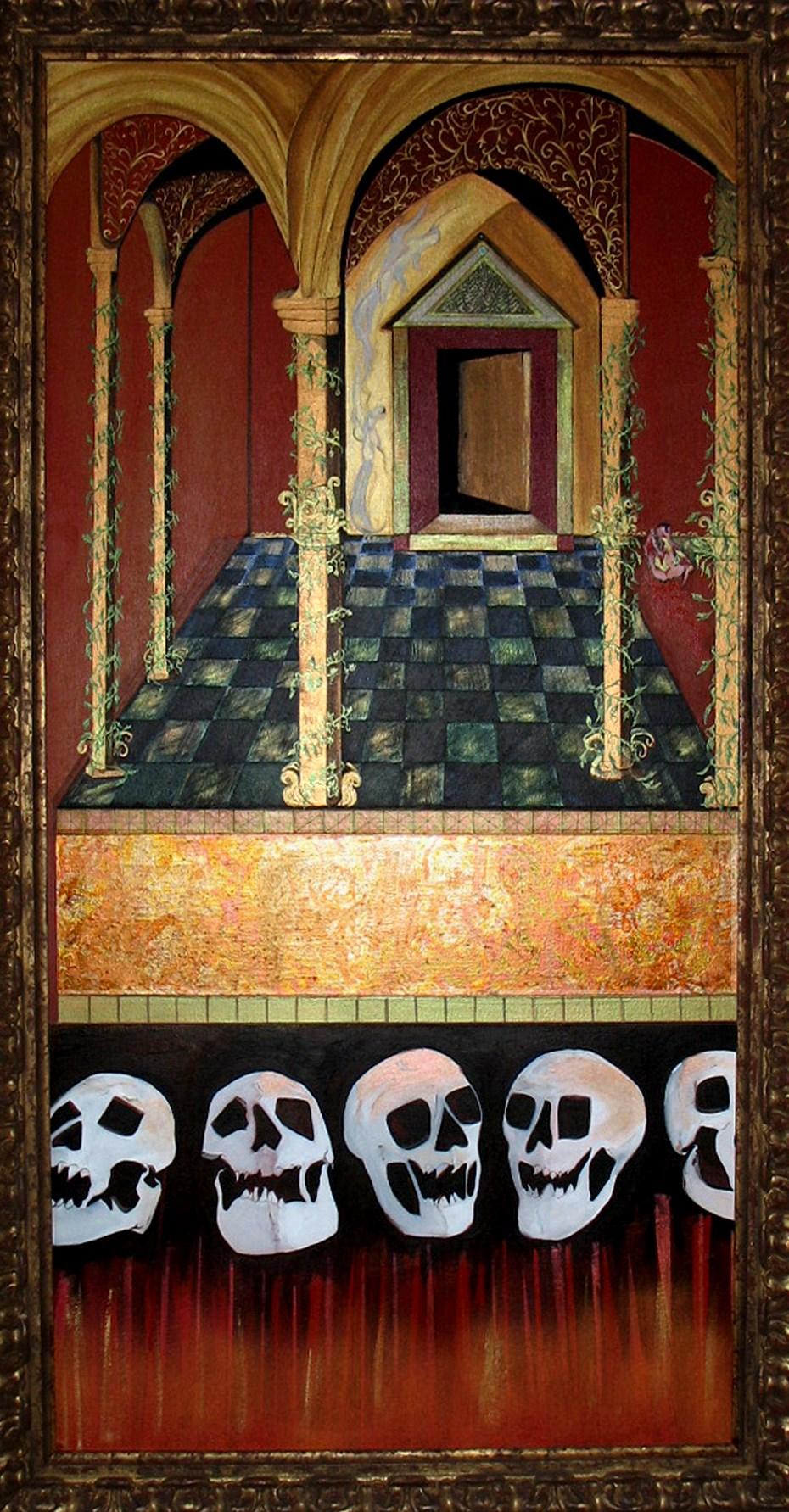
19
Cheryl Bookout. Sacrifice. 2007. Acrylic, gold leaf and ink on canvas. 52 x 28 inches.
My images started as a process to work through my PTSD. It started the day the of the Soviet invasion of Afghanistan. The images that I created then have evolved into symbols of all the various groups who have fought in the Middle East. The world’s never ending thirst for oil is fanning the flames of War ever brighter. These images carry with them the horrors of War for oil, but also try to contain a hope for Peace.

20
Paul Bouchard. The Price of Oil #4. 2008. Mixed media. 14 x 19 inches. *
My work explores ideals of a consumer society and how our accumulation of stuff fuels the Petroleum Paradox. What factors contribute to our insatiable desire for things and how do we arouse a social consciousness in challenging this trend? My work uses bold, colorful, and simple elements to provoke this dialogue. How can we persuade individual choices surrounding consumption and the use of oil to positively rebalance the sustainability of our planet and health of our communities?

21
Tracy Brown. Massive Pile Up. 2012. Digital Archival. 16 X 20 inches. *
My landscapes are inspired by a ubiquitous aspect of our car-dependent culture: asphalt. I focus on planned and accidental elements where the human-made and natural environments meet and interact. I painstakingly recreate overlooked patches of ground with unexpected materials and put them in a new context. I hope that you will join me in contemplating or relationship to the land and humankind’s attempts to control, contain, and exploit nature.

22
Lois Bryant. Lucky Find. 2011. Mixed media (foam padding, artificial flower petals, rocks, caulk, paint, glue, pennies). 36 x 34 inches.
Let’s get this straight. Plastic bags are NOT biodegradable. They are made from crude oil. The oil gets pumped to the earths surface, evolves into various commodities, in this case, plastic shopping bags, and eventually 94.8% of non recycled bags end up in the landfill where they do not break down into organic material. Most likely, every single piece of plastic ever created is still here on this planet.
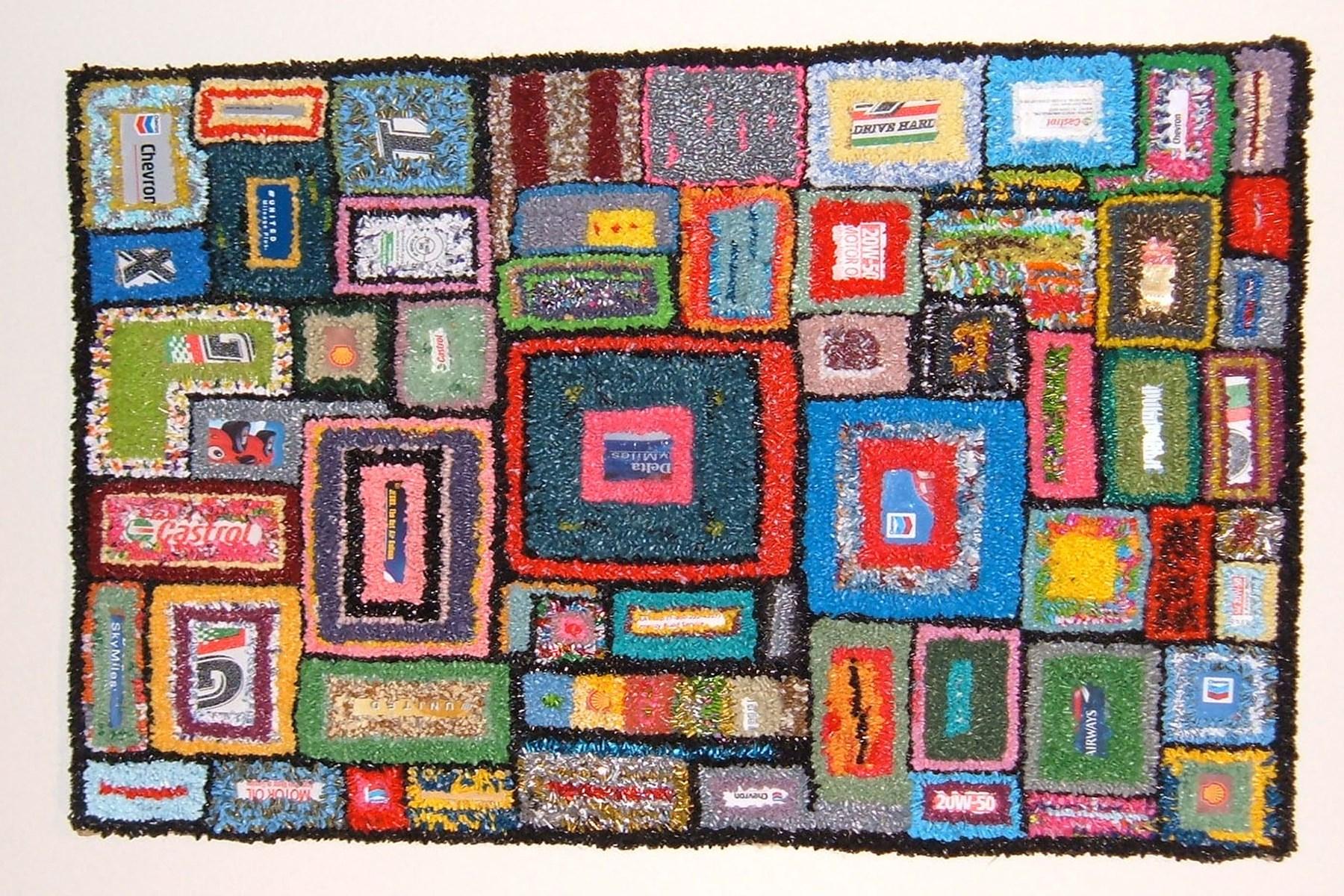
23
Allegra Burke. Drill it, Pump it, Carry it, Bury it. 2010. Plastic shopping bags, expired credit cards, hand hooked on reclaimed burlap coffee bag. 23 x 17 inches. *
It’s like a 1950s horror movie, no matter how high the cost of gas, consumers are compelled to drive big trucks and SUVs. They’re hypnotized by car commercials and mesmerized by the feeling of power they have driving their three ton assault vehicle to work or to the market. High costs, air quality, climate change, wars in the Middle East nothing will change their mind, because they’re Oil Zombies.

24
Donna Catanzaro. Oil Zombies. 2011. Archival print. 13 x 13 inches. *
In the process of grieving my father’s death, I found that I was also grieving his service as a Vietnam Veteran, his life coping with untreated Post Traumatic Stress Disorder, and the toll it had taken on my family. I sat in my studio and watched as soldiers my age and younger went to war, were sacrificed, and/or came home with the same set of issues that weren’t addressed from the Vietnam era. Memorial Archive is a grid of forty-five portraits of deceased soldiers from the Iraqi/Afghanistan war.
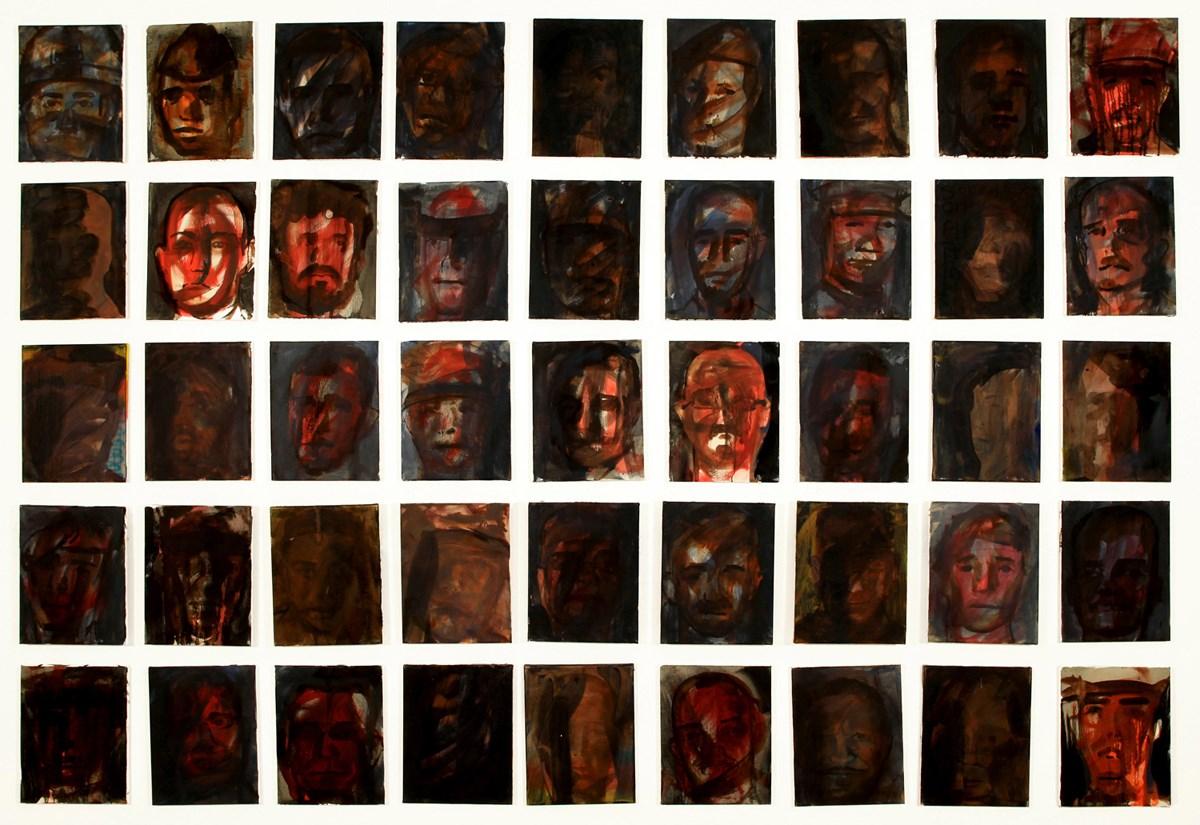
25
Rachel Clark. Memorial Archive. 2009. Oil on canvas. 11 x 14 inches.
This spill series began in 1968 with the Torry Canyon, Exxon Valdez, the BP, among others. The BP spill depicts several blackened heads of the eleven men who perished. The Oil Rig is heavily collaged with black paint and glitter, representing the paradoxical beauty of texture on metal. The seal on the billboard was inspired by a photo of a baby seal suffocating in a sea of oil.

26
Janet Culbertson. The Oil Rig. 2009. Oil, iridescent pigments, collage materials on rag paper. 33 x 23 inches.
Independence and Dependence depict contrasting possible futures concerning oil dependence.
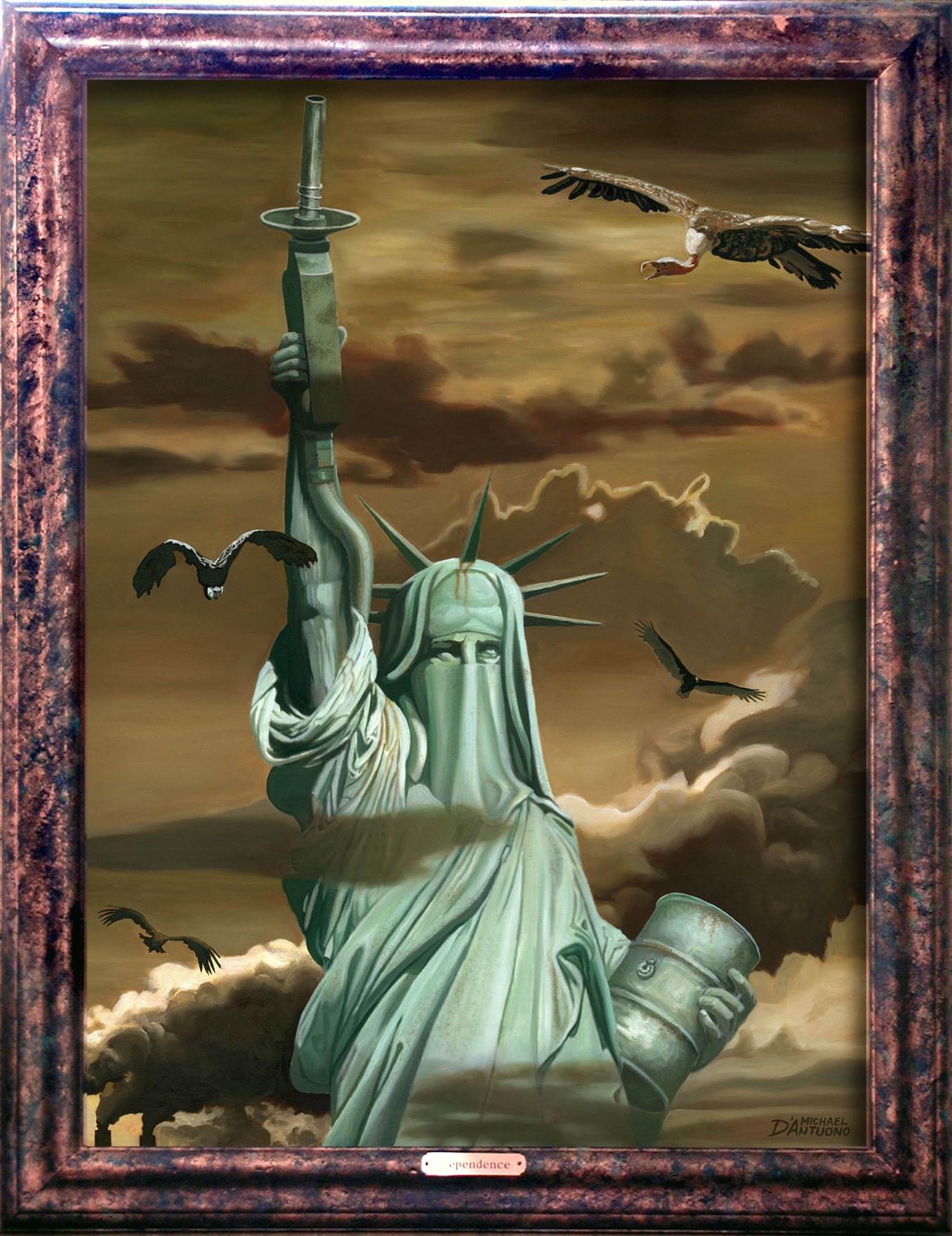
27
Michael D’Antuono. Dependence. 2009. Oil on Canvas. 46 x 36 inches.

28
Michael D’Antuono. Independence. 2009. Oil on Canvas. 46 x 36 inches.
Throughout history commerce and trade has played an important role in the development of civilizations. With the discovery of oil, this only sped up the Industrial Revolution and mass-produced items that inundate our lives today; like the automobile. These luxuries come with a price. Our environment is starting to show the effects of fossil fuels that we have become so dependent on. In my work I am exploring the object/artifact, as well as the subconscious associations of form within this realm.

29
Derek Decker. Air Quality. 2012. Porcelain and wood. 9 x 37.5 x 24 inches.
As dwellers of suburbia, generation after generation, the idea that we are literally hostage to the combustion engine no matter how nostalgic or beautifully it is packaged is a reality. So then, will we ever reach the future? Will we ever be released from the shackles of the petroleum industry? Or will we simply always be waiting on the wind?

30
Sherri Denault and Margie Glass Sula. Beauty Feeds the Beast. 2011. Digital photography on watercolor paper with India ink. 9 x 12 inches.
We need to move from a hierarchal petroleum based energy system with hazards to our health and environment to a lateral system collecting sustainable energies at millions of local, regional and continental sites. Then bundle energies and share them over an energy internet to maintain a sustainable economy. Moving from industrial, 2 communications to 3 sustainable energies is new, emphasizing distributed energy. Governing institutions may function as complex political organisms and operate synergistically and reciprocally.

31
Liz Dodson. 1,2 Moving Out from Oil. 2011. Paper. 11 x 13 inches.
Alice Dubiel. The effect of snowmelt on past cultural landscapes: Gyeongsangnam-do creates Gyeongsangbukdo weather (대구Daegu weather report). 2011. Collagraph with digital chine collé, polyester lithograph, relief embellishment, edition of 15. 15 x 11 inches. *
Exploring alternatives to the Western landscape tradition, I currently focus on the atmosphere. I was artist in residence at North Cascades National Park, where the archeologist advised, to understand wilderness, we must be open to the existence of many past cultural landscapes. In romanticism, we experience the conflict of notions of pristine wilderness with human activity in ecosystems. These works reflect concerns of retreating glaciers in North Cascades, and increasingly intense typhoons (Maeri) during my visit to Korea.

32
History is as much about the present as it is about the past. We are an America whose identity has been forged by myths that no longer hold true. Despite pretensions to motivations such as liberty and freedom, petroleum and its geopolitics have dominated Anglo American activity in the Middle East for a full century. The world’s age of oil has also been its era of American supremacy. Not merely a symbol of US global power, petroleum has been its fuel for military might. A potent change in this country’s domestic and foreign policy is religion’s new political prowess and its role in the projection of military power in the Middle East Bible Lands—the new military-industrial-religious complex.

33
Sally Edelstein. Oils Well That Ends Well. 2010. Collage appropriated vintage imagery from 1940s, 50s, 60s. 29 x 39 inches.
*
NASA’s James Hansen says that fossil fuel extraction is expanding, including high-carbon sources that are driving further climate change practically out of humanity’s control. This raises profound moral issues as young people, with no possibility of protecting their well-being, will bear the principal consequences of actions and inactions of today’s adults.
We are led to believe that we can debate this, or technology will deliver us, or that we’re powerless against the forces that prevail. That’s nonsense the success of propaganda.

34
Johnny Everyman. Obama Wants You! 2012. Oil on canvas. 44 x 33 x 4 inches. *
Hung out to Dry I juxtaposes natural and altered sky/water images to create ‘landscapes’ that are simultaneously picturesque and disturbing, serene and ominous. The original photograph was shot on the Amazon River in Peru. To emphasize the fragile and transitory nature of the subject, the images adhere to thin paper attached to the wall by clothesline and clothespins. A glossy resin-coated surface highlights the wetness while the title and installation suggest the contrary. The direction of energy development, sustainable or destructive, will determine the ultimate fate of our natural resources and our planet.

35
Trish Foschi. Hung out to Dry I. 2010. Photo giclee, resin-coated paper, clothesline, clothespins. 45 x 30 inches.
The consequence of a relentless pursuit of an increasingly scarce resource in a highly competitive world is ultimately war. I created A Load of Bull to portray the pure folly of such a terribly misguided policy and those who bear the responsibility for promoting it and unleashing it upon the world.

36
Pam Foss. A Load of Bull. 2007. Acrylic on canvas. 52 x 60 inches.
LOUISIANA, PURCHASED: This project examines the consequences of greed and neglect in relation to the loss of wetlands in the lower coastal parishes of Louisiana and the health of people living in close proximity to oil refineries along the Mississippi River. The foremost factors compromising the welfare of these regions and their citizens remains our insatiable demand for petroleum products and the irresponsible methods by which that demand is satisfied. Several communities are all but destroyed; how do we honor that loss?

37
Terri Garland. Broken Lament, near Montegut. 2011. Archival pigment print. 12 x 18 inches. *
This piece is from a sub-series of ‘Flowers and Monsters’ called The Wellands. The Wellands focuses on a landscape ravaged and polluted by oil and the need thereof. It specifically communicates my own fear and experience with fracking, which transformed the land surrounding my parents home, polluted their water and increased the occurrence of earthquakes (almost non-existent before) by 50% in the course of three years.

38
Catherine Gilbert. The Wellands #1. 2011. Oil and acrylic on canvas. 48 x 30 inches.
My work is always about water. It’s rooted in childhood memory, science, Socioeconomic and historical influences. But this is not water. It’s resin on Plexiglas. Two petroleum based products. It’s a metaphor for our dependence on natural resources and the unnatural things we do with them.
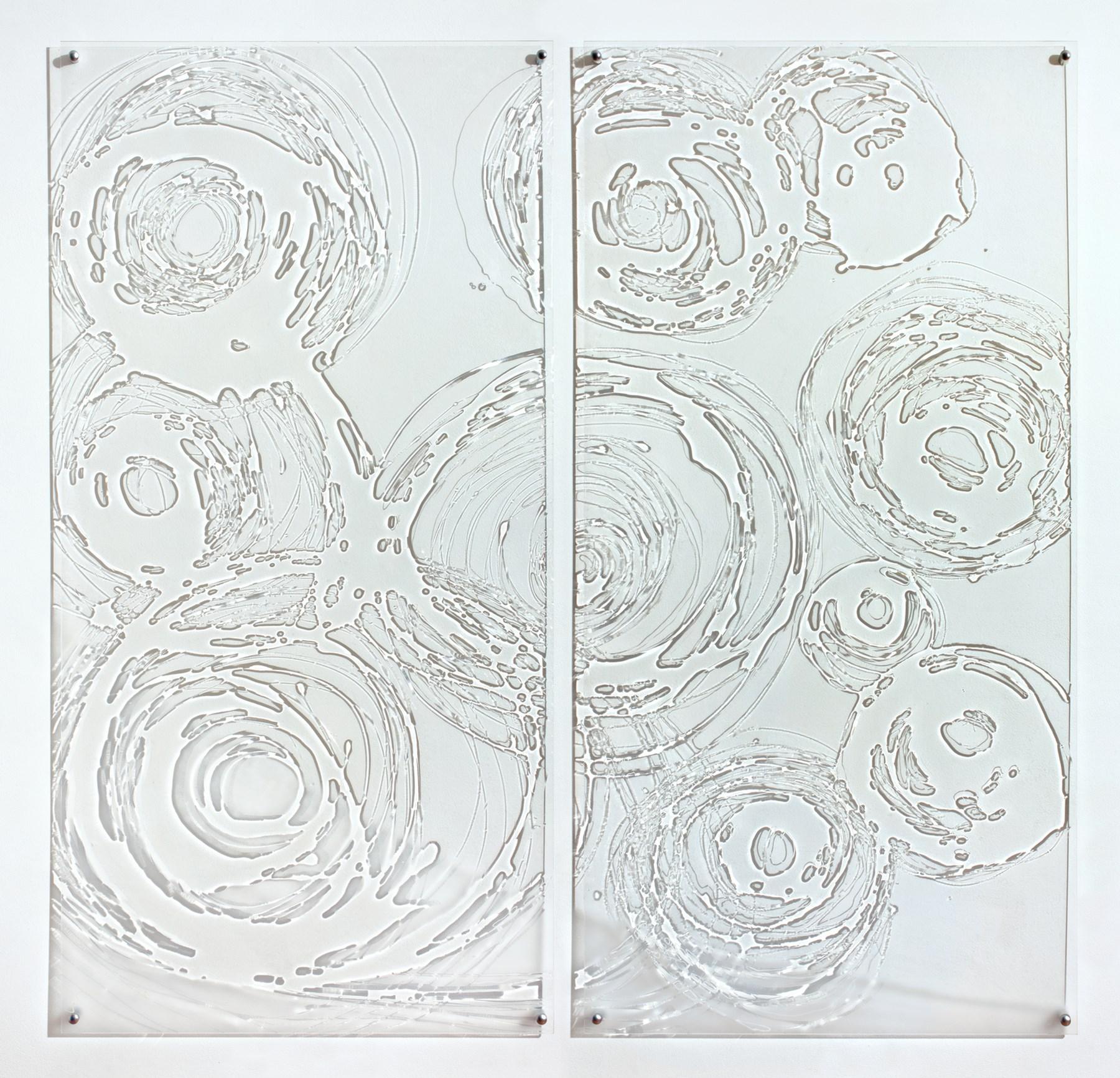
39
Carla Goldberg. Drip Drop This Is Not Water. 2011. Resin, Plexiglas, ink. 48 x 50 inches. *
We are bombarded with quick read images. Creating images that are not quick reads, but rather, involve work to read, seems counter to people’s patience. But that is what this work requires, patience. The word remembers’ root means ‘to be mindful of’. A moment of mindfulness can surprise us with a felt sense of connection. Faster travel, quick information, utilizes tons of energy daily—at what cost? The price of mindless speed is the forgotten relationships with ourselves and others that fuel us in a more sustained way.

40
Maeve Grogan. Remembering. 2009. Wax, pencil, charcoal on paper. 26 x 26 inches.
I was horrified by the occurrences leading to the before, during, and after explosion of the deep sea drilling rig, Deepwater Horizon. I wanted to express my grief, anger and sorrow at the loss of life and the destruction of the environment.

41
Livia Gus. Deepwater Horizon. 2011. Oil on canvas. 24 x 30 inches each.
This series of work is my reaction to the ongoing wars that I believe are fundamentally about the control of oil and natural resources. I examine the juxtaposition of Islamic religious mantras with Judeo/Christian mantras and the resulting consequences of war and perceptions of freedom. The layers of images with mixed meanings and text, often biblical, are meant to provoke the viewer’s visceral senses to evoke change and reveal the layers and inner complexity of the dreams, nightmares and emotions of our turbulent society.

42
Karen Gutfreund. I Want My WMD’s. 2008. Mixed media on canvas. 36 x 36 inches. *
I attempt to transform objects by moving them from this world into a surreal realm. I am interested in the transience of materials—their past, present, and future. I want to catch and put together materials at that instant where the latent reality can be unlocked. My work deals with the relationship between humans and nature, including global warming and oil company hegemony. Most of us continue to rely on petroleum-based routines even though we know the potential harm. The theme of my exhibition work is ‘crude reliance’.

43
Andrew Hamill. This Has Been Going On A Long Time But Not Like This. 2012. Digital print. 8 x 10 inches.
My photographs transport swimmers in the Hamptons into polluted flood water in Iowa. Recent catastrophic Iowa flooding was only supposed to occur every 100 years, but one occurred only two decades earlier. I was living in the state when the 1993 flood happened and was shocked to hear about the second. The flooding is indicative of climate change as well as those who ignore its destructive power.

44
Aimee Hertog. Fun in the Sun. 2009. Digital photo. 12 x 9 inches.
For many decades America has been in a lose-lose situation importing oil from dictator-led countries and Saudi Arabia. Our government has been subsidizing oil companies that are already the most profitable corporations in the world. These companies do not want to invest in solar and other renewable energies because it will cut into their profits. British Petroleum had major accidents before the December 2010 deadly blowout. Instead of large penalties BP was given a slap on the wrist.

45
Suzanne Hodes. Blowout/ British Petroleum. 2012. Charcoal, collage, gesso, oil on paper. 50 x 40 inches.
This piece confronts the question of what is in the future for our children. What will be the lingering effects to our environment as a result of the Gulf Oil Spill and the world’s dependence on oil? This work presents the idea of conversations going on at all levels among those who have no human voice and those still too young to be heard. If we could stop and listen, what would these discussions sound like?

46
Roxane Hollosi. Cyclops The Discussion. 2010. Photos and photo transparencies. 16 x 20 inches.
These paintings explore how petroleum products have poisoned nature, our food, and our own bodies.
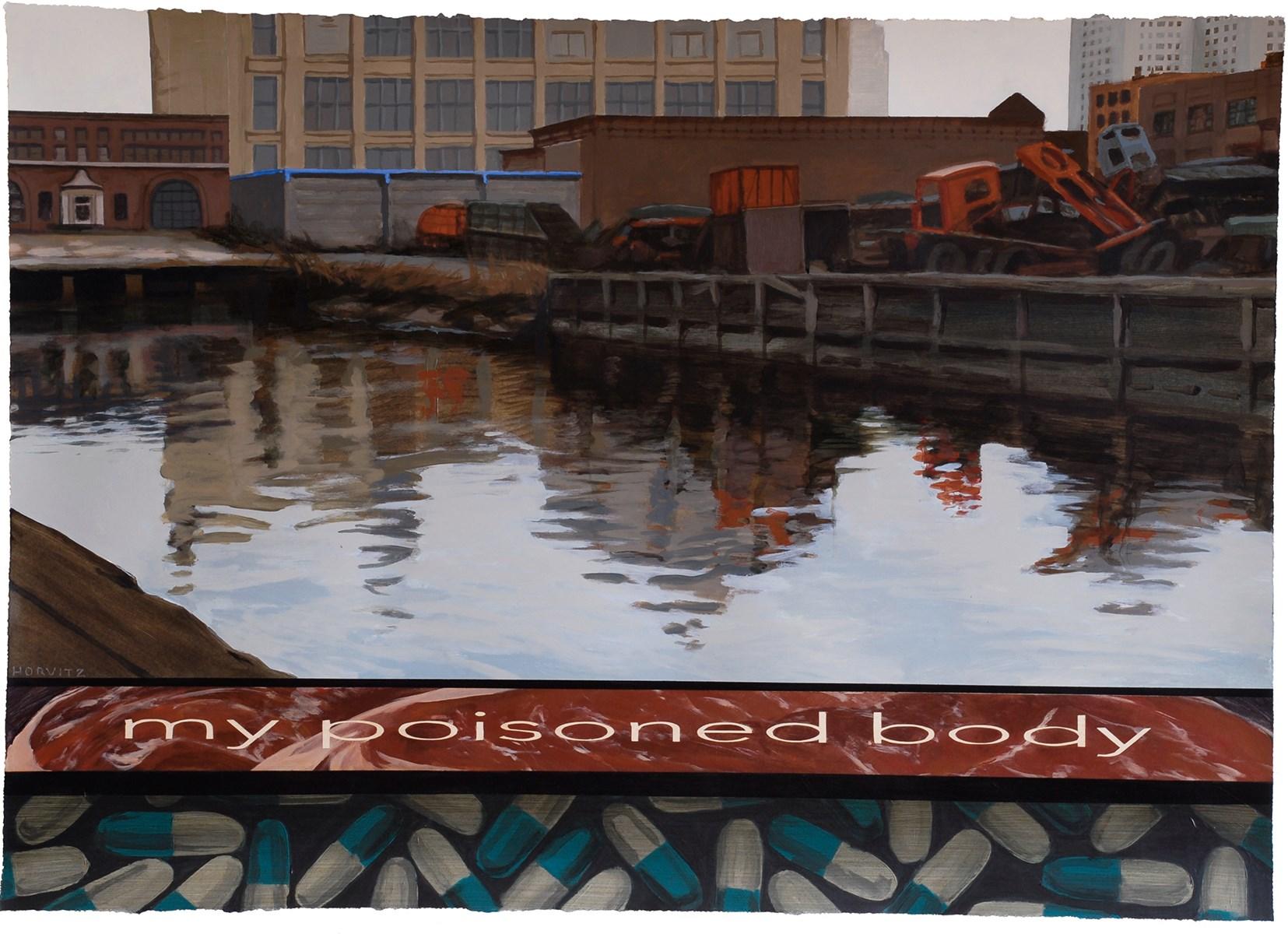
47
Shelah Horvitz. My Poisoned Body. 2009. Acrylic on paper. 22 x 30 inches.
Oil dependent as I am, conflict arises in creating works with oil-based etching ink and petroleum-based solvents that pollute our environment and cause risk of respiratory illness. As ink floats and silts like pools of thick, beached oil on the paper’s surface, process mimics contamination. Much of my imagery resembles imperiled wildlife, with oil-stained feathers that have drifted ashore in a state of decay a transgressive state. A bone to pick, my own personal Petroleum Paradox lies in the obsessive recreation of imagery that intimates, yet also perpetuates, our immanent self-destruction.

48
Patti Jordan. Bone-Picker (Corpus 012). 2011. Ink and graphite on paper. 30 x 50 inches.
I began to work with post-consumer detritus by chance. While walking my dogs on the beach, we’d vie for who could chase down the colorful trash that washed ashore. To keep the objects from being washed back to sea, I took them to my studio. Soon this cheerful yet dangerous plastic detritus became my main material and main subject. I want my art to increase awareness of the plastics polluting our oceans and give voice, like a breeze across the land, to the need to develop plastics that break down naturally in our ecosystem.

49
Robin M Jordan. Breeze Above Ground. 2012. Plastic flower parts, umbrella detritus, steel, plastic sheet, monofilament, glass beads. 68.5 x 16.3 inches. *
Timespans depicts underground streams of fossils. The title is a reference to both the slow process of fossilization and the labor-intensive detail of this drawing. This piece is part of a collection titled Pareidolia a series of drawings that I create by spilling and blotting ink on paper before deciding what to draw. I began working on the Pareidolia series as part of my interest in exploring the relationship between chance and order.

50
Vesna Jovanovic. Timespans. 2008. Watercolor, colored pencil, graphite and white pencil on paper. 29 x 24 inches.
Larinde. Sky Color
1. 2012.
*
The darkened sky, houses and animals, as well as the anemic fields and trees speak of the severe polluting effect of oil on our food supply, our dwellings, and by extension on our collective health.

51
Noreen
of Oil
Digital photo printed on Epson Velvet Fine Art Paper. 13 x 19 inches.
I see the oil industry as a dinosaur both undesirable yet comfortably familiar, like an old friend you know you shouldn’t hang out with. It is a rugged symbol of human progress and empire building that has enveloped the ugly raw beginnings of bloodshed and violence with the technology of golden power. I can’t help but have hope as I see the sun shining on the distant summits that SOMEDAY, the spirit of a utopian society or simply the brightest minds of a new generation will bury this giant beast in its own waste.

52
Amy Larsen. Petro-saurus. 2012. Acrylic on paper. 24 x 30 inches.
Our petroleum-based transportation system demands a huge, complex system of roads. We are accustomed to them, but they’re a potent symbol of the dangerous effect of human activities on the earth and nature.
My work describes, and in a sense celebrates, the structures that we’ve created for cars. I’m accustomed to this artificial landscape, and I often find it beautiful. I work to convey my emotional response to these huge structures—a response which includes comfort, awe, and a sense of doom.

53
Molly Magai. Viaduct 6. 2011. Oil on canvas. 16 x 30 inches. *
To create the images in the North Gateway Transfer Station Project I made nearly 6000 photographs of individual recyclables at a solid waste transfer and material recovery station in Phoenix, Arizona. I entered the photographs into a database and gave them keywords from categories including material, color, and use. The database functions as an image-bank from which I create prints of selected image groups. The keywords used to generate these groups are chosen to create visual impact and highlight consumer choices.

54
Paho Mann. Water Bottles. 2009. Archival pigment print. 40 x 50 inches. *
My ‘frack art’ is expressly made to grab the much needed attention of the public and to educate them about the many dangerous effects that fracking poses to their lives. The vintage toy characters I use as my models represent us. Often the viewer’s initial smile fades to concern once this toxic reality sets in. There is nothing ‘clean’ or ‘safe’ about fracking for natural gas as the industry ads want you to believe. My work illustrates some of the irreversible consequences that thousands of Americans have already endured.
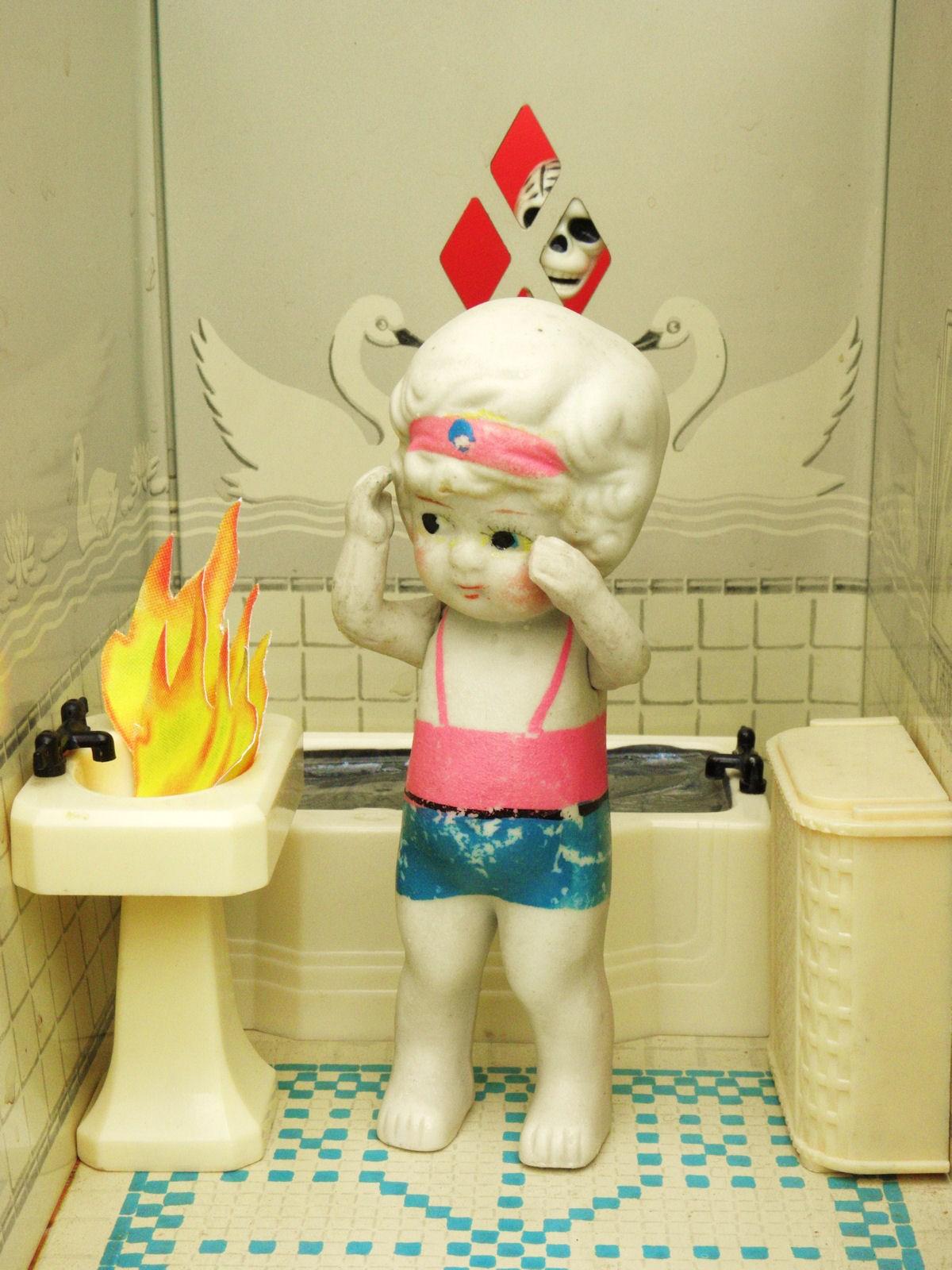
55
Brandi Merolla. What the Frack?! 2011. Digital photograph. 16 x 20 inches.
For the past several years my work has focused on climate change. Coral Frolic is one of a series of “travel poster” prints. These tongue-in-cheek prints show the dark side of seemingly innocent pleasures. They encourage people to visit the coral reefs now, before our addiction to oil destroys them by warming and acidifying the oceans. I began this print by using linoleum plates in a modular fashion. I then added digitally created collage elements and hand stamped type. The result is a handmade, unique, mixed technique print.

56
Barbara Milman. Coral Frolic. 2008. Mixed technique print on paper, linocut, type, collage. 22 x 30 inches. *
Focusing on the fossil fuel nature of our consumption, my work addresses the disastrous effect it has on the food chain and the next generation. By ignoring the cycles of the present ecology, the images of pushing the limit are reminders of our excesses. When we run out of petroleum, how will the food get to our tables? Collecting odd objects that pertain to the fishing and oil industry, my work is concerned with the connection of the two sources in terms of both sustaining and threatening our survival.

57
Mitzi Mize. Floundering in Oil & the Cost of Fish. 2011. Digital print on canvas, gallery wrap. 17 x 27 inches. *
I work in a process that combines sculpture and photography. I create original sculptures which I then use as the main subject matter in my photographs. I create the sculptures in clay, cast them in urethane resin and then paint them with acrylics. I integrate the sculpture into a natural environment which I then photograph, incorporating various elements of the landscape into the composition and narrative. The sculptures are deities from my own personal mythology. They are fusions of different animal, botanical and human elements. Through this blending of elements I explore the idea of the interconnectivity of all things in nature. Although I intentionally maintain a degree of ambiguity to allow for a multitude of interpretations, each piece suggests a narrative. In Ascent, the turtle/cats represent the myriad other creatures with whom we share the planet. Their climb up a hill represents the uphill battle we inflict on many animals who struggle to survive as we pollute their habitats. As all of nature is interconnected, what we do to the environment, we do to ourselves.

58
Andrea Morganstern. Ascent. 2010. C-print. 44 x 32 inches.
My artwork involves an ongoing exchange of bringing to the surface what was interior and bringing what was surface to the interior experience. These poetic photos were taken at the La Brea Tar Pits in the shadows of the Los Angeles County Art Museum. All of which adds a layer of visual irony as viewers discover the rich array of colors and forms as water, oil, tar and light quietly intermix. The resultant imagery invites us in stillness to envision new relationships with ancient fossils beyond mindless consumption.

59
Sandra Mueller. Oil, Water & Me. 2010. Archival digital print on matte paper. 9 x 9 inches each. *
I explore the order of things, both in how we attach meaning to random juxtapositions of objects, and the emotional roots of the world we create personally and politically. I am interested in the connection between art’s aesthetic experience and its transformative power. The Garden of Eden plays Barbie, Eve, and Botticelli’s Venus against the sinister ramifications of the petroleum references the dinosaurs, Vaseline, and the “Shell.”

60
Rosa Naparstek. Garden of Eden. 2012. Barbie doll, Vaseline, half shell, plastic toy dinosaurs. 15 x 7 x 7 inches.
My paintings are composed of pieces or elements of cityscape and landscape arrayed to set up a contrast and dialogue between the beauty of the painted image and the harshness of the underlying reality. The more beautiful or traditional landscape parts are ominously paired with images of industry, particularly oil refineries, to create a world with a sense of dread or uncertain future. Skies become polluted waters, airplanes fall to earth, and rolling hills subtly mutate and hide secrets.

61
Patty Neal. Wonderland. 2006. Oil on linen on wood panels. 41 x 26.5 inches.
Via the physical and conceptual imagery that acknowledges the reality and myths of American working-class car culture, the work can be seen as 21st century postindustrial landscape painting. Just as the Hudson River School artists themes of discovery, exploration, and settlement in a pastoral setting reflected the American zeitgeist of the 19th century, this body of work reconciles the contemporary landscape of ever-present screens and brand imagery with the sublime debris and cultural nostomania of post-industrial America.

62
Rob Neilson. Ford de Lis. 2011. Painted steel. 73 x 50 x 16 inches.
What happened to the city of Detroit is not unique. The city is mired in the decay that defines it in the national consciousness. This photograph is an examination of many things, the failure of an industry, the loss of a city and the devastation of an economy. The abandonment found in these damaged landscapes serves as silent sentries to our neglect.
My intention is to raise awareness of what our culture allows to occur right beneath our feet.

63
Lynnda Pardoe. Detroit Urban Cathedral. 2007. Photograph. 38 x 48 inches. *
Society’s fluctuating attitudes towards defense, vulnerability and complacency often means science is ignored. I use embroidery to communicate provocative environmental and social issues. I present quantitative information in an unusual combination of stitched text and graphics. The work provides an opportunity to consider the scientific and historical context inherent in current events and social questions.

64
Bonnie Peterson. War Graph. 2011. Velvet, brocade and silk. 58 x 70 inches.

65
Sara Petitt. Headlight #1. 2012. Photograph. 13 x 19 inches.
Cars and trucks destroy our lives in New York City. These cars and trucks were parked in the streets of the Chelsea art district.
My life is affected every day by oil. When I was a child and the ‘bottom fell out’ of the oil industry, early 1980, causing my family to lose everything including the house. Growing-up road trips with passing fields of oil derricks and smelling the refining towns long before you approach them. As an adult having to ration the use of utilities/driving distances due to cost increases. Even the very art medium I use is based in petroleum products the plate, ink, and ink modifiers. I am dependent on petroleum for my livelihood.

66
Roxanne Phillips. Road Trip. 2012. Reductive Relief. 17 x 17 inches.
Out juxtaposes my gas receipts with diminishing bars of soap and an emerging stain. Oil is a necessary ingredient in many detergents. We therefore consume oil even as we try to cleanse away the evidence of how we’ve used it. Alluding to Lady Macbeth, these images explore the ongoing relationship my contemporaries and I have with crude oil. In an era of growing efforts to reduce our collective dependency upon this commodity, Out reflects the seeming futility of that endeavor.

67
Stefani Rossi. Out. 2009. Oil, wax, and image transfer on panel. 8 x 8 inches each. *
The impact of the largest accidental marine oil spill in the history of the petroleum industry has continued long after the well was capped. For Gulf Distortions, I-XII (2010-2011), I chose twelve images that represent my sense of the estrangement between nature and humans. To visualize my sense of environmental fracture and displacement, I manipulated the photographs, submitting the images to an intensely fraught facsimile process. The reiterated images are screen printed onto frosted Mylar with interference pigments.
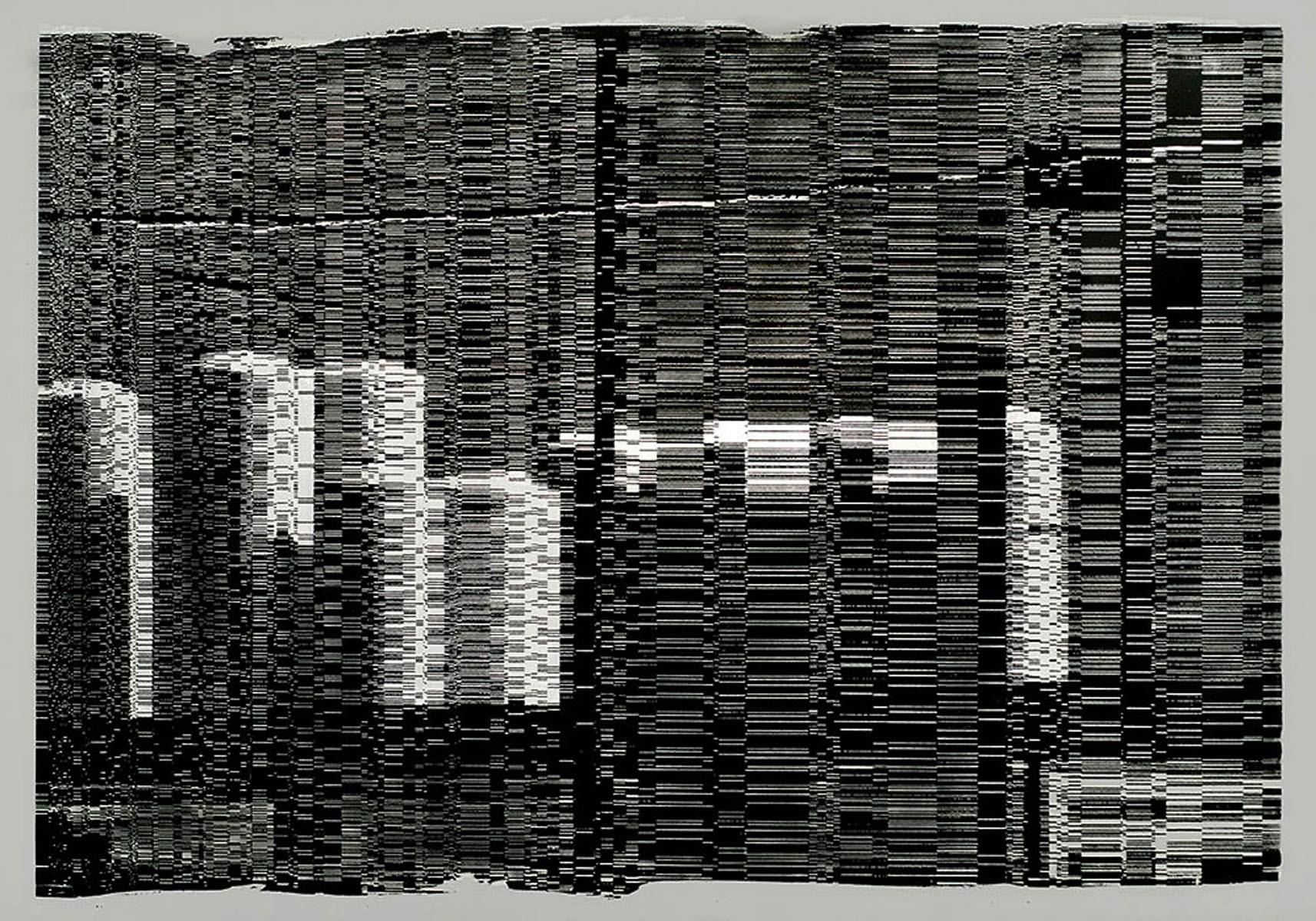
68
Soledad Salame. Gulf Distortion XI. 2011. Silkscreen on Mylar with interference pigments. 24.5 x 35.5 inches. *
The Petroleum Paradox is old with a correlation between war and oil resources. The lure, greed and power of government and oil companies have created violence, corruption and poverty worldwide. The dominance of essential resources has shed blood evidenced in the Middle East and Africa. Society should focus on renewable energy, use of natural materials, solar energy and conservation. My photographs are the manifestation of the lure at the gas pump, emissions polluting our skies, and emotions of war written on our streets.

69
Loredana Sangiuliano. Smokestakes. 2011. Digital C-print. 8 x 10 inches. *
The installation Autocratic Democracy has much to do with the decisions made in America and those who make them. These decisions are founded mainly in profit and oil. They are held together with industry and American ingenuity. The flag bears the most weight, holding the highest commodity which then drips down, torturing our currency and fore fathers. This cycle is fully connected and continues endlessly until one resource runs out...
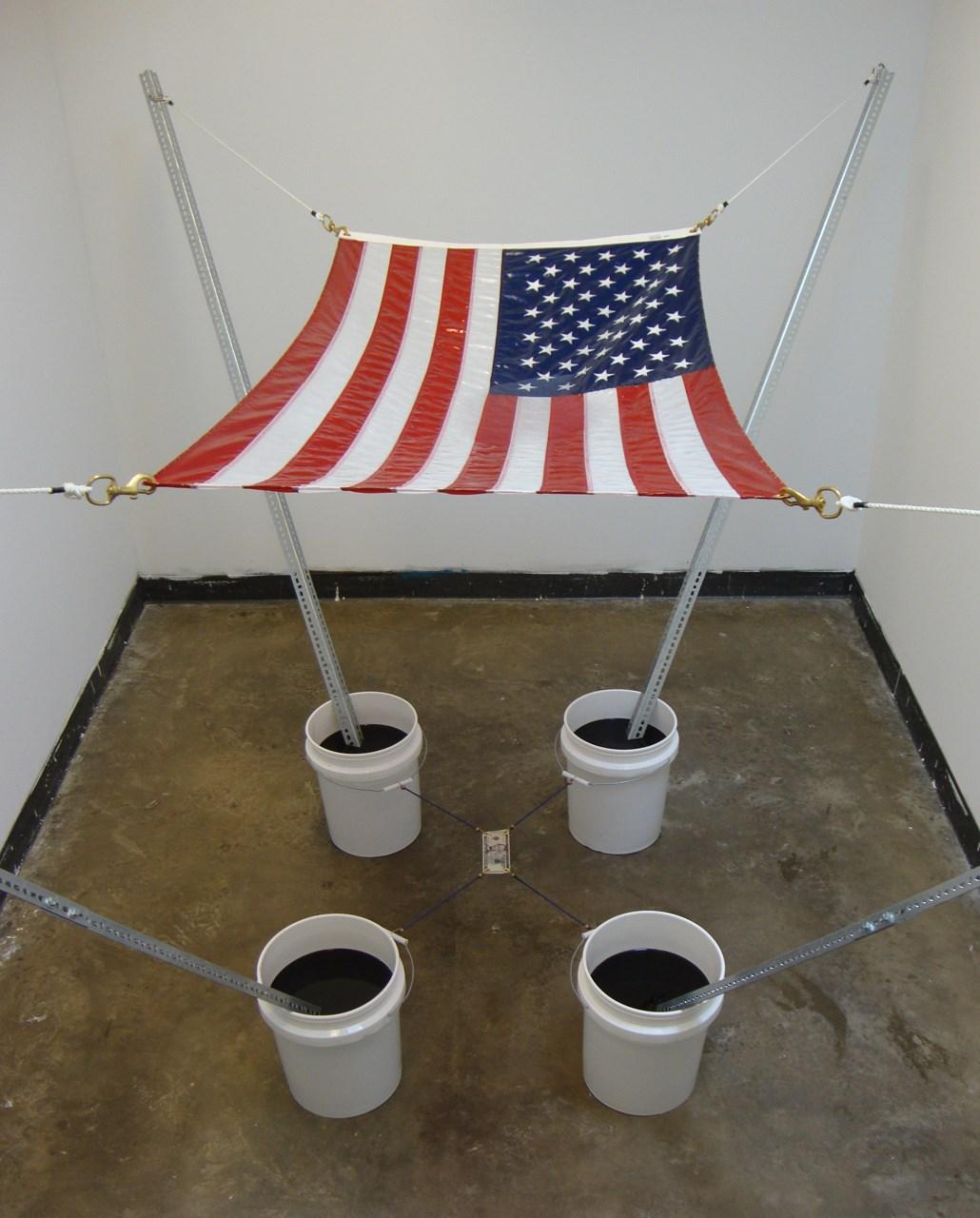
70
Samuel Scharf. Autocratic Democracy. 2010. Found industrial objects, US flag and US currency. 42 x 70 x 64 inches.
This piece imagines the land as completely taken over by petroleum products, mountains have been replaced by motor oil, streams by petroleum jelly, and trees and fields by gasoline. As a landscape, brushstrokes are replaced by logos. A fracking tower looms in the distance. Hovering over the landscape, an old fishing guide reminds us of a more innocent time.

71
Debbie Schore. Fishing Waters. 2012. Watercolor, marker, paper collage. 30 x 22 inches.
These multi media works on polyester film were created in response to the recent tsunami in Japan. The imagery was created by using a mash up of Japanese flood photojournalism juxtaposed with renaissance masterpieces and 18th century etchings of whaling- one of the first super fuels. My work tends to reflect on the consumptive demands of a contemporary utopia and the repetition of human behavior throughout history. I am interested in the paradox of the demands of unlimited growth faced with finite resources.

72
Manju Shandler. Leviathans 1. 2011. Mixed media on printed and sewn polyester film. 42 x 57 inches. *
In light of the recent environmental disaster of the Gulf Coast oil spill, I thought I’d create a symbolic artwork representing the perils of pollution to such fragile ecosystems. Here, the black heron represents pollution, signified by his oily black color and the black stylized water ripples reaching out to the clean silver waves inhabited by the white heron. A dying fish is shown floating in the foreground. A golden sun is setting in a darkening purple sky.

73
Lynnette Shelley. The Poisoner. 2010. Mixed media on paper. 18 x 24 inches.
Our current national identity was formed by access to cheap oil. If that ends, there will be massive changes in every facet of our lives. I sought to create images that are an investigation and a critique of our use of resources. I employ vanitas and memento mori to communicate to the viewer a suggestion of the impermanence of life and the futility of excessive consumption. I pair oil with tulips in my photographs because it controls our economy and drives policy in a manner similar to the Dutch experience with tulips.

74
Katherine Sifers. After Coorte, #08. 2011. Inkjet color print. 21 x 25 inches.
Simone Spicer. Bountiful Harvest. 2011. Corrugated plastic and cardboard, spray paint, popcorn, chips, cheese curls. 108 x 96 x 96 inches.
It is important that people look at waste. Someone I know said ‘waste is the only sin’. We are all contributors to the growing piles of junk and contamination of the planet. I am trying to understand this, open people’s eyes to it, and take responsibility for it through my work.

75
Industry and over population are the roots of my newest work, as I see more, hear more and feel more about where we are as a species. I love us, and I can’t believe what we do, all of us, everyday. In my archeological digs through neighborhood recycling bins looking for plastic, I am thrilled to acquire products of such technological mastery, in alluring shapes and colors and so much! I wonder if our unparalleled consumption, an obvious affront to the natural world, is natural. Are we just running our course? From Stone Age, through Bronze Age, and now the Plastic Age? As a sculptor I find this an intriguing thought.

76
Simone Spicer. Pumped. 2011. Small motors, upholstery, polar fleece, water bottles. 15 x 40 x 40 inches. *
Can you believe that American teenagers, sitting in mile long lines to gas up their car during the 1974 oil embargo ended up, twenty plus years later, driving cars that got even worse gas mileage than the one that they were waiting to gas up in 1974? Or, why can’t oil and religion and guns and money just get along?

77
Greg Stange. Jesus and the 12 Disciples (American version). 2009. Mixed media assemblage sculpture. 21 x 12 x 12 inches. *
Photographer Deborah Mills Thackrey sees the world through a different lens. These works are glimpses at a beauty that exists even when rainwater is polluted with the run-off of oils and fluids from the internal combustion engine. Like the unearthly beauty of a polluted sunset, there is irony at the juxtaposition of nature and our unheeding use of petroleum.

78
Deborah Mills Thackrey. Manhole Cover, Woodstock, NY. 2008. Archival pigment print. 16 x 20 inches. *
I thrive when photographing everyday images that others may have bypassed without giving a second glance; I see beauty in everything! I am always on a quest for images I can shoot and then manipulate into my artwork. My digital photography mainly focuses on nature, the intricate textures, shapes and forms she creates on her own. I shoot those images using unusual angles or perspectives, and then twist and tweak them to make them my own. The images submitted for this show were all oil spills in a parking lot.

79
Linnea Tober. Oil in yellow & orange. 2011. Photography. 16 x 20 inches.
The painting Clean Up offers a surreal look at the aftermath of an oil spill. Bags of debris fill the space and look as if they may go on forever. This clean-up involved collection of oil-coated sand, vegetation, debris and dead sea life. It takes extensive man power to remove the oil from a contaminated area. The work is slow and costly, and disposal of the waste is problematic. The lasting environmental effects of such spills are still unknown.

80
Lucy Traeger. Clean Up. 2009. Acrylic on canvas. 20 x 20 inches. *
While our government caves to the oil industry to drill baby drill, polar bears and penguins are drowning because of melting sea-ice and the Gulf of Mexico is dying. How can we be so rude as to not consider or care about the effects of our over-consumptive lifestyle on other species? With this art I aim to unearth truths buried by the constant barrage of corporate-controlled visual images telling us to consume more while Rome burns. I offer my work as cultural resistance to ecocide.

81
Michelle Waters. American Nightmare. 2007. Acrylic on canvas . 20 x 30inches. *
I use a computer to repeat images that I stitch together visually in order to make a pattern resulting in tapestry like, spatially flattened compositions. Through decorative patterning, the work of art draws the viewer into a narrative that invites a discussion about ecology and/or sociopolitical realities of the contemporary world around us. Meaning is implied by the juxtaposition of images, in this case, the beach, the oil tankers or oil company logos. Conclusions are left to the viewer.

82
Margi Weir. Under the Boardwalk. 2011. Digital ink print on rag paper. 18 x 11 inches. *
Jenifer Wightman. Backlit: Gonatites and Cyanthophillidae on 14th St. L Subway Balls. 2011. Images of Devonian era fossils discovered by 1800s NY paleontologists are backlit by their contemporaries combusted at the East River Electric Generating Station. Laser Decals, Variable Dimensions, on until removed. *
One ritual common to all is energy use. Everyday, invisible streams of electrons run our phones, elevators, and lights. Images of fossils (photosynthesized Devonian sun preserved by one geologic process) are turned into decals for light fixtures in the hopes that they might be seen. These creatures beautiful, temporary and finite material expression- are backlit by the combustion of their contemporaries (compressed into natural gas by another geologic process) in electric generating stations. There is poetry in illumination.
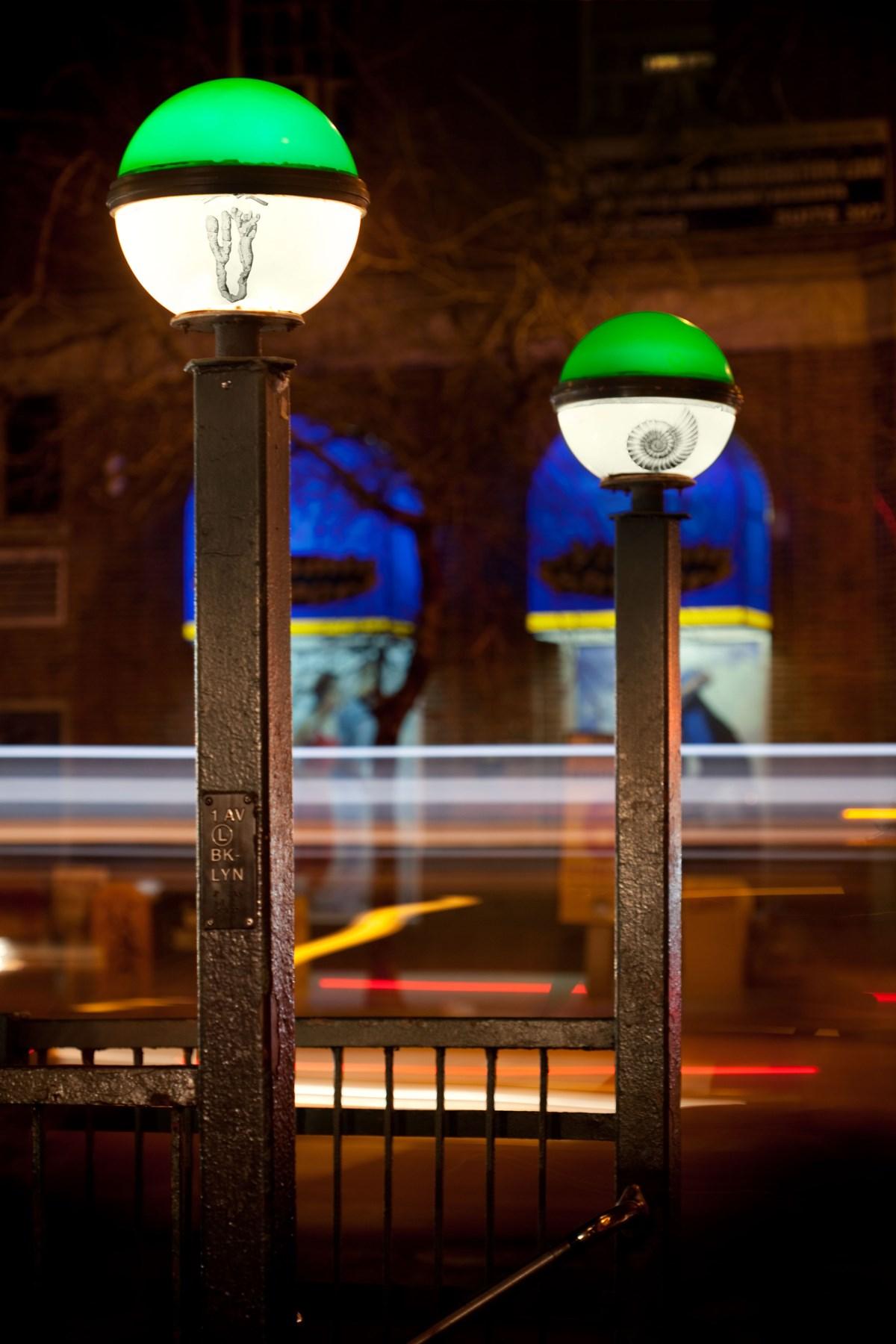
83
Photo credit: Benjamin Heller
Innocent Oil, was created using pristine white plaster casts of oil barrels that are in stark contrast to the surrounding black painted wall. Crude oil is not to blame, we are the consumers. Oil is innocent and we are guilty of using it. The addictive use of this fuel is a significant cause of climate change. The abuse of this technologically outdated ‘fuel from hell’, the structure of our current society and political system, and the unwillingness to change are all factors that can and will be devastating to our environment and our lives. Change needs to happen now, not for our grandchildren, but for us, in the present.

84
Roscoe Wilson. Innocent Oil. (with detail). 2012. Plaster, acrylic paint. Dimensions vary due to space.
Tower of Babel is part of the series of oversized pop-up books called Connection. I feel this pop-up book best illustrates our global ecological problem. Oil is at the center of this ecological problem which not only causes tension between nations but threatens our future if no global solution is found. We are called for universal stewardship of our natural resources. We are all connected; we are all affected. We must cherish or we will perish.

85
Helen Zajkowski. Tower of Babel. 2002. Paper, acrylic, glue, images. 20 x 36 inches.
After the Japanese Fukushima Dai-Ichi plant breach and the 25th anniversary of Chernobyl this past year, I dwelled on the disasters we have wrought in our relentless consumption of fossil fuels and voracious hunger for alternative energy sources. The Gulf Oil Spill prompted me to paint a series entitled “Imminent Threat.” Nuclear plant and mining catastrophes in Asia, the Americas and Eastern Europe resulted in my painting Elkridge.

86
Patrcia Zalisko. Elkridge. 2012. Acrylic on canvas. 19 x 51 inches.
ARTIST ESSAYS
87
Ecological Art As Gift: A Means To Facilitate Positive Changes In The World Water Crises
by Krisanne Baker
Water is the foundation of life; the connective might of the universe. Therefore sustaining the water systems must be the foundation of planning and development. 1
Betsy Damon, ‘Keepers of the Waters: Visions and Solutions’
You may ask, “What is ‘ecological art’?” Ecological artist (EA) Aviva Rahmani defines ecological art as “a practice often in collaboration with scientists, architects, key planners, activists, engineers and other artists that result in direct intervention in environmental degradation. Often the artist is the lead agent in this work.”2 Rahmani invites artists and researchers of all genres to collaborate and discourse the world’s mounting ecological problems in her weekly podcast at http://www.ghostnets.com.
Faced with environmental uncertainties, we need to rethink assumptions concerning conditions within reach and beyond our own experiences. It’s necessary to remember the limits of the give and take system between this planet and its inhabitants. Through their art, EA such as Aviva Rahmani, Ichi Ikeda, Betsy Damon, and Helen Mayer Harrison & Newton Harrison bring awareness and solutions to ecological problems worldwide. All five of these artists deal with issues of water in diverse manners and mediums.
There are hundreds of ecological artists currently at work on projects that will somehow bring attention to environmental problems, or embark upon solutions. This artist/writer became very aware of other EA upon viewing ‘Weather Report: Art & Climate Change’ curated by Lucy Lippard in 2007 at the Boulder Museum of Contemporary Art.3 The blockbuster ecological art show formulated by Marda Kirn, Founder and Director of Eco/Arts, was an educational experience that I wished so many more people had the opportunity to experience. Indeed, as denials of environmental problems are (somewhat) being put to rest, one can now thankfully find a burgeoning number of ecologically concerned exhibitions.
One huge environmental issue is that of the Earth’s lifeblood: water water quality, water availability, and water rights. (See watertreaty.org.) Hydraulic fracturing, or ‘fracking’ as it is called, for natural gas deposits is high on my endangered waters radar right now in 2012. Global warming or climate change, re-routed, polluted, dammed or pumped dry water sources result in degraded changes in the environment and living conditions of all populations. Concern for survival motivates and inspires ecological artists to look hard at situational catalysts and incorporate healing* measures into their artistic practices this often involves scientific and sitespecific research, as well as collaboration within a community whose inhabitants lives and areas of expertise touch upon or even produce the catalysts. The word ‘healing’ or ‘to heal’ is defined as a positive improvement or change in a system, and used here describing the positive outcome ecological art has on an ailing environment and culture.4
88
Threat to survival is the concept that through further entropic decline,5 there will not be enough potable water, air to breath, ocean conditions to spawn fish, or arable land to sustain all living creatures on planet Earth. The decline manifests over more than a century of neglect and pollution, over-utilization of natural resources, growing capitalist industrialization and agribusiness, growing gryes of plastic waste in the oceans, and most recently the privatization and commoditization of water. (U.S. citizens decry the price of gasoline at the pump, but then are astoundingly willing to purchase plastic bottles of water at four times the price of gasoline, without batting an eyelash.) These compounding factors also weigh most heavily in early effects of global warming, with changes in climate, weather patterns, acidification and warming of our oceans, melting polar ices, and rising sea levels.
In the case of worldwide waters and access rights to potable water, the paradigm of the crisis is that the minority (in this case politics and corporations) is transgressing the majority (the environment and its inhabitants). Ironically, the minority holds the power to control water—or as Christopher Manes says, we are experiencing “economic rage against the marginalization of the underclass and the monolithic power of multinational corporations. And there is a growing green rage against the destruction of the Earth and its breathtaking profusion of life.6
For our fractured Earth, we can reverse all of these entropic trends with ecological artists leading the way in regeneration. Ecological art does just this: it emphasizes renewable gifts to the environment and cultures, shares knowledge, opens opportunities for dialogue and creative problem solving, involves people socially in their communities and environment, and possibly even helps to advance issues of conflict into evolving directions of potential and hope. The artists’ gifts given to the environment will, in turn, be given from the environment back to the people meaning that it is possible for the decay and disorder of the world to move toward harmony and renewable energy sustaining a healthy environment and ensuring our survival.
Krisanne Baker is a Maine-based ecological artist and activist concerned specifically with water issues, and an art educator.
1Betsy Damon, artist’s website: www.keepersofthewaters.org
2Aviva Rahmani. Ghost Nets Virtual Concert series, a weekly Internet interview podcast series. www.talkshoe.com/talkshoe/web/talkCast.jsp?masterId=1210&cmd=tc.
3Lucy R. Lippard, ‘Weather Report: Expecting the Unexpected’, essay from Weather Report: Art and Climate Change, Boulder Museum of Contemporary Art, Boulder, CO, 2007
4Encarta World English Dictionary definition: heal v
1. vt to make a person or injury healthy and whole
2. vi to be repaired and restored naturally, for example, by the formation of scar tissue
3. vt to repair or rectify something that causes discord and animosity
4. vti to get rid of a wrong, evil, or painful affliction
Encarta® World English Dictionary © 1999 Microsoft Corporation, Bloomsbury Publishing Plc.
5Jeremy Rifkin, A New World View. NY: The Viking Press, 1980.
6Christopher Manes, Green Rage: Radical Environmentalism and the Unmaking of Civilization. Boston, Toronto, London: Little, Brown & Company, 1990, Epilogue.
89
ARTIST DIRECTORY
90
Elaine Alibrandi
www.artistsites.org/Alibrandi/ Concord, Massachusetts
Scott Anderson
www.scottandersonpainter.com
Hartford City, Indiana
Marcia Annenberg
www.mannenberg.com
New York, New York
Krisanne Baker
www.krisannebaker.com
Waldoboro, Maine
Ulla Barr www.scwca.org/archives/ar/arPage.php?m=103838&s=a
San Clemente, California
Kristen Baumlier www.kristenbaumlier.com
Cleveland Heights, Ohio
Cheryl Bookout www.cherylbookout.com
Los Angeles, California
Paul Bouchard
www.paul-bouchard.artistwebsites.com
Saratoga Springs, New York
Tracy Brown
www.tracybrownart.com
Tucson, Arizona
Lois Bryant
www.loisbryantstudio.com
Ann Arbor, Michigan
Allegra Burke
www.fiberdimensions.com
Santa Rosa, California
Donna Catanzaro
www.donnacat.com
Windham, New Hampshire
Rachel Clark
www.rachelclark.org
Athens, Ohio
Janet Culbertson
www.janetculbertson.net
Shelter Island Heights, New York
Michael D'Antuono
www.ArtandResponse.com
Beacon, New York
Derek Decker www.deckerceramics.com
Edinboro, Pennsylvania
Sherri Denault and Margie Glass Sula sherridenault.com and margieglasssula.com
Morris, Illinois
Liz Dodson
www.LizBrennerDodson.com
Minneapolis, Minnesota
Alice Dubiel
www.planetart.us
Seattle, Washington
Sally Edelstein
www.sallyedelsteincollage.com
South Huntington, New York
91
Johnny Everyman www.johnnyeveryman.com
Chadds Ford, Pennsylvania
Trish Foschi www.trishfoschi.com
Santa Fe, New Mexico
Pam Foss www.pamfosssculpture.com
Bel Air, Maryland
Terri Garland www.terrigarland.com Soquel, California
Catherine Gilbert www.catgilbert.com
Brooklyn, New York
Carla Goldberg www.carlagoldberg.com
Nelsonville, New York
Maeve Grogan www.maevegrogan.com
Palo Alto, California
Livia Gus twelve2thou@aol.com
bronx, New York
Karen Gutfreund www.karengutfreund.com
San Jose, California
Andrew Hamill
andrewhamill1@gmail.com
New Paltz, New York
Aimee Hertog
www.aimeehertog.com
Montclair, New Jersey
Suzanne Hodes www.suzannehodes.com
Waltham, Massachusetts
Roxane Hollosi www.roxanehollosi.com
Atlanta, Georgia
Shelah Horvitz www.shelahhorvitz.com
North Andover, Massachusetts
Robin M Jordan www.robinmjordan.com
Brooklyn, New York
Patti Jordan www.pattijordan.com
Montclair, New Jersey
Vesna Jovanovic www.vesnaonline.com
Chicago, Illinois
Noreen Larinde
www.NoreenLarinde.30.art.com
Pacific Palisades, California
Amy Larsen sagegale1@yahoo.com
Waterville, Washington
Molly Magai www.mollymagai.com
Seattle, Washington
92
Paho Mann
www.pahomann.com
Dallas, Texas
Brandi Merolla
www.ScenesFromTheAttic.com
Narrowsburg, New York
Barbara Milman
www.barbaramilman.com
El Cerrito, California
Mitzi Mize www.studioz.me
Gainesville, Florida
Andrea Morganstern www.andreamorganstern.com
Bridgewater, Connecticut
Sandra Mueller
www.sandramueller.com
Malibu, California
Rosa Naparstek
www.artistsunite.ning.com/profile/RosaNaparstek
New York, New York
Patty Neal
www.pattyneal.com
Brooklyn, New York
Rob Neilson
www.robneilson.com
long beach, California
Lynnda Pardoe
www.wooloo.org/lynnda
Chicago, Illinois
Bonnie Peterson
www.bonniepeterson.com
Houghton, Michigan
Sara Petitt www.gallery307.org
New York, New York
Roxanne Phillips
www. roxannephillips.com
St. Louis, Missouri
Stefani Rossi
www.stefanirossi.com
Crawfordsville, Indiana
Soledad Salame
www.soledadsalame.com
Baltimore, Maryland
Loredana Sangiuliano
www.loredanastudio.com
New York, New York
Samuel Scharf
www.SamuelScharf.com
Washington, D.C.
Debbie Schore
debs@wowsignal.com
Teaneck, New Jersey
Manju Shandler
www.ManjuShandler.com
Brooklyn, New York
Lynnette Shelley
www.lynnetteshelley.com
Ambler, Pennsylvania
93
Katherine Sifers
www.katherinesifers.com
Washington, D.C.
Simone Spicer
www.simonespicer.com
Wyndmoor, Pennsylvania
Greg Stange
www.stangmont.com
Worthington, Ohio
Deborah Mills Thackrey
www.dmt-art.com
San Jose, California
Linnea Tober
www.linnea-tober.artistwebsites.com
Havre de Grace, Maryland
Lucy Traeger
www.lucytraeger.com
Palo Alto, California
Michelle Waters
www.michellewatersart.com
Redwood Estates, California
Margi Weir
www.margiweir.com
Detroit, Michigan
Jenifer Wightman
www.audiblewink.com
Brooklyn, New York
Roscoe Wilson
www.roscoewilson.com
Hamilton, Ohio
Helen Zajkowski
www.helenzajkowski.webs.com
Stamtord, Connecticut
Patrcia Zalisko
www.pkzart.com
Hoboken, New Jersey
94
EXHIBITION COMMITTEE
Karen Gutfreund – WCA Exhibition Director

Marcia Annenberg
Dara Alter
Trudi Chamoff Hauptman
Rozanne Hermelyn
Heather Stoltz
WCA 2011-13 Board
Executive Committee
President
Priscilla Otani, Artist, Partner Arc Studios & Gallery, San Francisco, CA
President-Elect & WCA Chapter Community Initiative
Brenda Oelbaum, Artist, Independent Curator, Ann Arbor, MI
Treasurer/Secretary
Margaret Lutze, Adjunct Faculty, Northwestern, DePaul, and Loyola Universities, Chicago, IL
Vice President & Chair WCA National Exhibitions Initiative
Karen Gutfreund, Curator, Art Consultant, Artist, San Jose, CA
Past President & Chair WCA Legacy Initiative
Janice Nesser-Chu, Professor, Dir. of the Galleries & Perm. Collection, Florissant Valley College, St. Louis, MO
VP Chapter Relations
Ulla Barr, Artist, San Clemente, CA
VP Organizational Outreach
Ally Richter, Artist, Chair Palo Alto Public Art Commission
VP Development
Fay Grajower, Artist, Independent Curator, Member of Dreyfus Foundation Board of Advisors, Univ of PA
VP Special Events
Catherine Seaton, Brand Manager Harry & David
Staff
Director of Operations - Karin Luner, Artist, Gallery Director, Dietzspace, NYC
95














































































